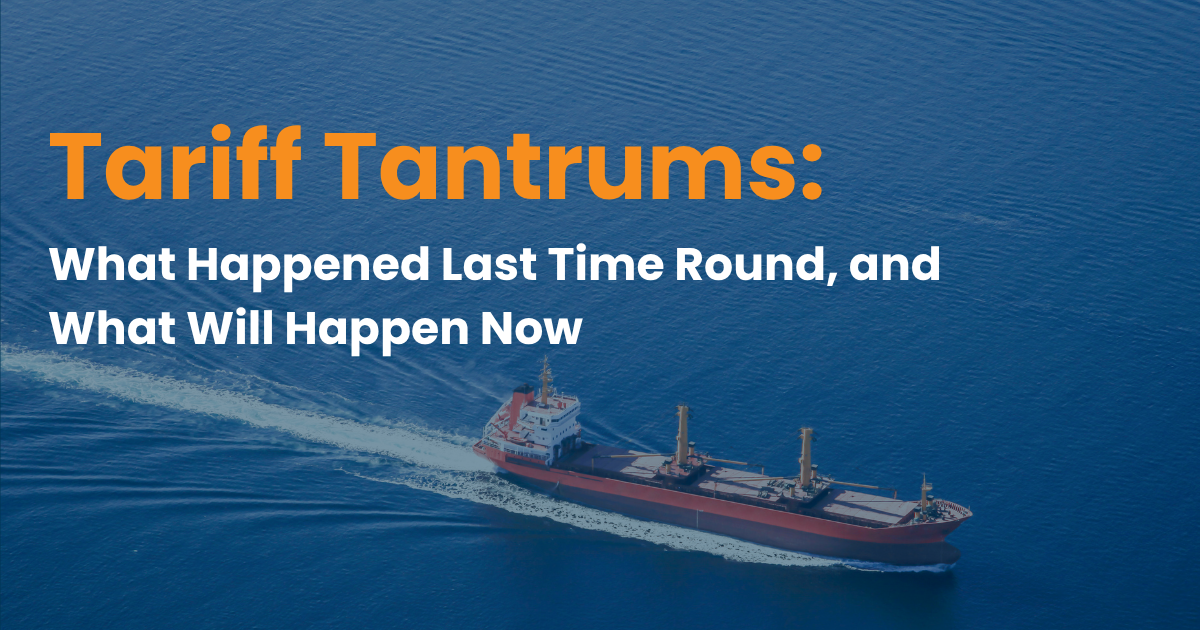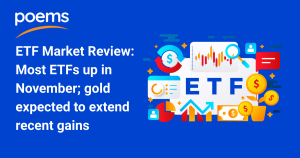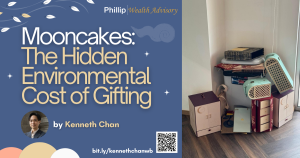Tariff Tantrums: What Happened Last Time Round, What Will Happen Now June 3, 2025

Trade tariffs have long been used as a tool for economic and political leverage. However, few tariff disputes in recent history have been as impactful as the trade war between US and China. Under the Trump administration, the US introduced a baseline tariff of 10% on all imports globally, with reciprocal tariffs applied to goods from over 180 countries.
One of the most affected was China, which is now facing a total tariff of 145%. As of writing, a 90-day pause has been implemented on further escalation of tariffs between the countries while negotiations take place, further highlighting the ongoing uncertainty.
What are Trade Tariffs, and why are they imposed?
Trade tariffs are taxes or charges imposed by a government on imported (and sometimes exported) products. They are often assessed as a percentage of the item’s value or a set amount per unit. So what is the purpose of Tariffs?
- Generate Tax Income
- Correct Trade Imbalances
- Political Leverage
- Protect Domestic Industries
A key objective of tariffs is to generate tax income.According to Capital Economics, an economic insight and data provider, tariffs implemented during Trump’s term were estimated to bring in around US$700 billion annually (WSJ, 3 Apr)
Governments may use tariffs to correct trade imbalances, usually trade deficits, where a country imports more than it exportsIn 2024, America’s trade deficit was a whopping US$ 98.4 billion
Tariffs can be used as a tool in diplomatic negotiations, where countries leverage them against other countries to further their own agenda on unrelated issues, such as military activities or immigration.
Another common reason for implementing tariffs is to protect a country’s domestic industries. Tariffs aim to make foreign goods more expensive, and push consumers towards buying domestic products.
However, this assumes that there is actually domestic production to meet local demand. In the current trade war, the US does not produce many of the goods being taxed. For example, 90% of iPhones are manufactured in China.
Tariffs during the Great Depression
Way back in 1930, the then US Representative. Willis Hawley and Senator Reed Smoot believed they had found a solution to protect American businesses and farmers from overseas competition during the early stages of the Great Depression: tariffs. The Smoot-Hawley Tariff Act, signed that same year, increased tariffs on over 20,000 imported goods.
In response, other nations raised their tariffs on American imports, with Canada imposing new tariffs on approximately 30% of the US’ exports to Canada. The US government also received protest notes from 23 trading partners. As a result, global trade declined by 66%, falling from US$4.4 billion in 1929 to US$1.5 billion in 1934. Unemployment, already rising due to the Great Depression, was exacerbated by the tariffs, increasing from 8% in 1930 to 25% between 1932 and 1933.
Rather than shielding the economy, the Act worsened the Great Depression. The US didn’t fully recover until World War II.
What Happened During the 2018 US-China Trade War
With fresh discussions about the latest tariff war, investors are now assessing whether it will mirror the past or take an entirely different course.
Origins and Impact
The US-China trade war started in July 2018, ultimately resulting in tariffs on approximately US$550 billion of Chinese products and US$185 billion of US goods.
The primary goal of the US tariffs was to reduce reliance on Chinese manufacturing. It also aimed to bring jobs back to the US and pressure China into adopting fairer trade policies. However, instead of achieving a quick resolution, the trade war resulted in prolonged economic uncertainty for nearly two years, impacting businesses and financial markets worldwide.
Countries and Industries Most Affected by Tariffs
Although the US and China were the main participants in the trade dispute, the effects of these tariffs extended far beyond their borders. Other economies, particularly those heavily involved in global supply chains, also experienced disruptions:
- The technology sector suffered significant setbacks as major companies like Apple and Intel relied on Chinese components for their products.
- China, once a leading importer of American soybeans, shifted its purchases to countries like Brazil,leaving US farmers with surplus crops and falling prices.
- The automotive sector experienced increased production costs as tariffs on steel and aluminum raised expenses for manufacturers, ultimately leading to higher vehicle prices.
- Retail and consumer product companies faced price inflation, as tariffs on Chinese-made clothing, furniture, and electronics led to higher costs for American shoppers.
Market Impact: How Financial Markets Reacted
Faced with uncertainty, businesses had to find alternative solutions to mitigate the effects of tariffs. Some companies relocated their manufacturing bases from China to other Asian countries,like India and Vietnam, to avoid tariffs on Chinese goods. Others lobbied the US government for tariff exemptions, arguing that higher costs would ultimately hurt American consumers.
Stock markets fluctuated in response to trade developments, with major indices such as the S&P 500 and the Dow Jones Industrial Average experiencing volatility whenever tariff hikes were announced or negotiations stalled. Investors found it increasingly difficult to predict market movements, as government policy often changes without warning.
What Investors Learned from the 2018 Trade War
US-China trade war tariffs highlighted how policy-driven uncertainty can be just as damaging as the tariffs themselves. Businesses struggled to make long-term investment decisions leading to reduced capital expenditure and slower economic growth.
Trade wars and tariffs ultimately reinforced the importance of portfolio diversification. Investors who were too exposed to tariff-sensitive industries, such as technology and manufacturing, faced significant losses. At the same time, those with a balanced approach, including safe-haven assets like gold and bonds, managed to weather the storm more effectively.
The Current Tariff Landscape
While the 2018 trade war was primarily a standoff between US and China, the current tariff discussions are no longer limited to it, with more than 180 countries and territories featured in President Trump’s tariff list. As of 17 April, the total cumulative tariffs on some Chinese imports, such as electric vehicles and syringes, reached 245%.These aggressive tariff policies have already sent a shockwave through global stock markets, with the S&P falling 10% YTD(17 April). Rising inflation remains a key concern today, and additional tariffs could further increase prices for goods, making it harder for central banks to control inflationary pressures.
How Financial Markets Are Reacting to Potential Tariffs
Institutional investors are already factoring in the risk of a new trade dispute. Many companies with global supply chains are exploring alternative sourcing strategies. Hedge funds and investment firms are positioning themselves in sectors that may be less vulnerable to tariffs.
Potential Outcomes and Scenarios
What the Best-case Scenario Looks Like
- Tariffs cause global supply chains to strategically reorganise, bringing manufacturing back home in US
- Domestic sectors like manufacturing, logistics, and IT companies that enable automation and reshoring can profit from this reorganisation
- Long-term benefits might be realised by investors who are positioned in these industries or in globally diversified funds, especially if geopolitical stability improves concurrently
- If tariffs are avoided or rolled back, financial markets could see a broad-based rally. This would benefit industries that previously suffered from trade restrictions
What a Worst-case Trade War Could Mean for Investors
- Tariffs can lead to retaliatory actions, raise the cost of input materials for American businesses, reduce profit margins, raise consumer prices, and thus reduce demand
- It will impact industries with little pricing power, such as consumer electronics, retail, and automobiles
- For investors, this can mean lower corporate profits, more volatile markets, and a move in capital flows from stocks to safer assets like gold or bonds
- If tensions escalate, a prolonged trade war could lead to higher inflation, supply chain disruptions, and lower corporate earnings
- In this scenario, investors might shift toward safer assets, such as gold, government bonds, and defensive stocks in industries like healthcare and utilities
Investment Strategies Amid Tariff Uncertainty
Whether it results in a best- or worst-case scenario, tariffs create uncertainty and impact investors’ confidence in the market. In the week ending 2 April, US equity funds recorded net selling of US$10.85 billion, while investors moved US$30.26 billion to safer investments in the form of Money Market Funds.Bond funds also saw a net inflow of $4.3 billion, while short term bond funds attracted a net $5.02 billion.
What’s the Move
1. Money Market Funds
A type of unit trust that invests in high-credit-rating, debt-based assets with short maturities, offering lower risk and more stability. They’re also highly liquid, providing investors with a place to park their funds while earning some returns.
- Phillip Money Market Fund
The fund aims to preserve principal value, maintain liquidity, and produce returns comparable to Singapore Dollar savings deposits.
2. Fixed Income Funds
A fixed income fund is a fund that invests primarily in bonds or other debt securities, and aims to provide a regular income. It helps to diversify investors’ portfolios and stabilise them in times of market volatility.
- Phillip Sustainable Reserve Fund
The fund aims to achieve a yield enhancement over the 6-month Singapore Overnight Rate Average (SORA). - United SGD Fund
The fund aims to achieve a yield enhancement over Singapore dollar deposits. - PIMCO Income Fund
The Fund aims to seek high current income, consistent with prudent investment management.
Conclusion
The 2018 trade war between US and China was a clear example of how tariffs can disrupt global markets. It increased costs for businesses and consumers and created uncertainty for investors. While the current economic environment is different in several ways, the possibility of new tariffs means that investors must remain prepared for similar risks.
By investing in safe-haven assets and maintaining a well-diversified investment strategy, you can navigate this uncertain environment with greater confidence. Whether tariffs lead to another round of economic turbulence or negotiations result in a more stable outcome, those who prepare wisely will be in a stronger position to adapt to whatever comes next.
Disclaimer
These commentaries are intended for general circulation. It does not have regard to the specific investment objectives, financial situation and particular needs of any person who may receive this document. Accordingly, no warranty whatsoever is given and no liability whatsoever is accepted for any loss arising whether directly or indirectly as a result of any person acting based on this information. Opinions expressed in these commentaries are subject to change without notice. Investments are subject to investment risks including the possible loss of the principal amount invested. The value of the units and the income from them may fall as well as rise. Past performance figures as well as any projection or forecast used in these commentaries are not necessarily indicative of future or likely performance. Phillip Securities Pte Ltd (PSPL), its directors, connected persons or employees may from time to time have an interest in the financial instruments mentioned in these commentaries. Investors may wish to seek advice from a financial adviser before investing. In the event that investors choose not to seek advice from a financial adviser, they should consider whether the investment is suitable for them.
The information contained in these commentaries has been obtained from public sources which PSPL has no reason to believe are unreliable and any analysis, forecasts, projections, expectations and opinions (collectively the “Research”) contained in these commentaries are based on such information and are expressions of belief only. PSPL has not verified this information and no representation or warranty, express or implied, is made that such information or Research is accurate, complete or verified or should be relied upon as such. Any such information or Research contained in these commentaries are subject to change, and PSPL shall not have any responsibility to maintain the information or Research made available or to supply any corrections, updates or releases in connection therewith. In no event will PSPL be liable for any special, indirect, incidental or consequential damages which may be incurred from the use of the information or Research made available, even if it has been advised of the possibility of such damages. The companies and their employees mentioned in these commentaries cannot be held liable for any errors, inaccuracies and/or omissions howsoever caused. Any opinion or advice herein is made on a general basis and is subject to change without notice. The information provided in these commentaries may contain optimistic statements regarding future events or future financial performance of countries, markets or companies. You must make your own financial assessment of the relevance, accuracy and adequacy of the information provided in these commentaries.
Views and any strategies described in these commentaries may not be suitable for all investors. Opinions expressed herein may differ from the opinions expressed by other units of PSPL or its connected persons and associates. Any reference to or discussion of investment products or commodities in these commentaries is purely for illustrative purposes only and must not be construed as a recommendation, an offer or solicitation for the subscription, purchase or sale of the investment products or commodities mentioned.
About the author
Darius Lee
Darius Lee graduated from the National University of Singapore with a Bachelor’s of Engineering degree. Life took him on a different path and he ended up spending 8 years in the Wealth Management space. He is as obsessed with the technical aspects of investing as well as the psychology that drives investors. In his free time, he enjoys reading about topics from Economics to Science Fiction.

 Buffer ETFs — What Are They and How Do They Work?
Buffer ETFs — What Are They and How Do They Work?  ETF Market Review: Most ETFs up in November; gold expected to extend recent gains
ETF Market Review: Most ETFs up in November; gold expected to extend recent gains  The ILP Debate: Why Singaporeans Struggle With Financial Product Decisions
The ILP Debate: Why Singaporeans Struggle With Financial Product Decisions  Mooncakes: The Hidden Environmental Cost of Gifting
Mooncakes: The Hidden Environmental Cost of Gifting 




